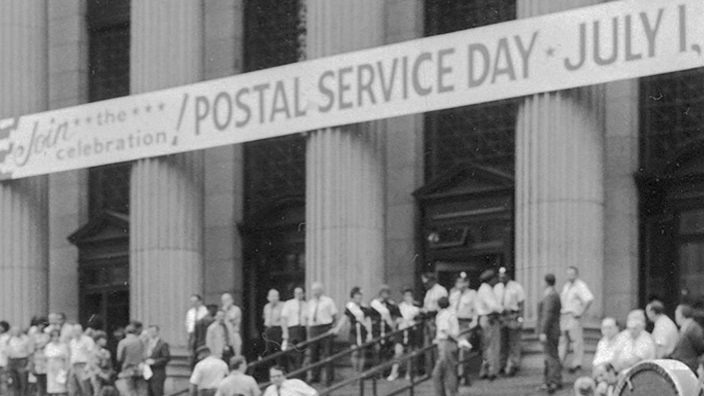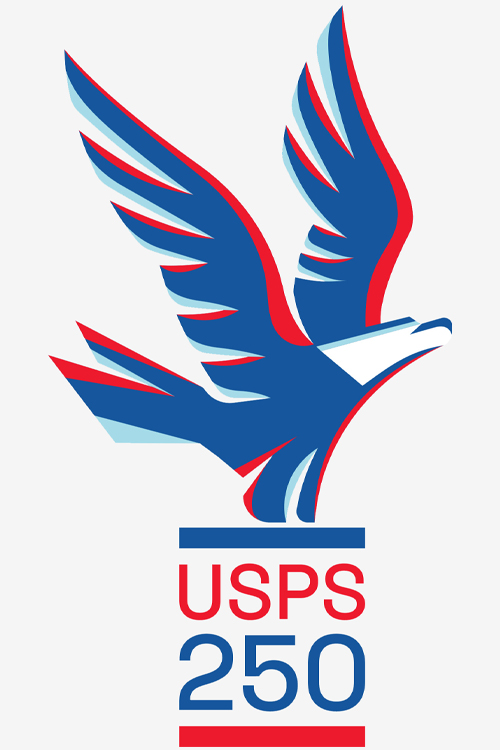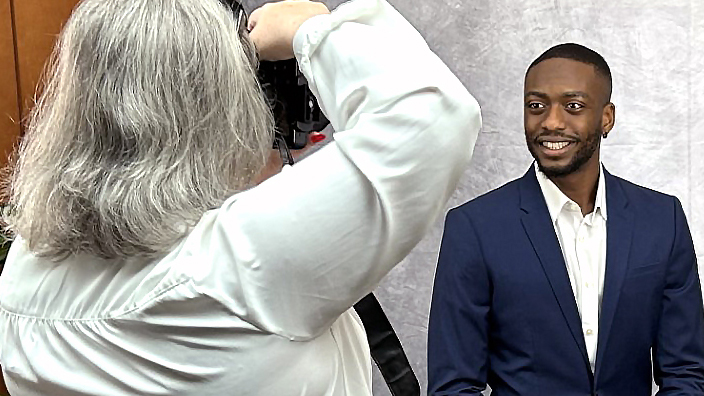
Crossing new frontiers
From 1925-1974, the postal system spearheaded innovations in delivery — and its own identity
The sky was the limit in 1925: An act of Congress authorized the postmaster general to contract for airmail service, and in 1926, the first commercial airmail took flight.
Trans-Atlantic and trans-Pacific airmail routes followed in the 1930s.
By the 1940s, the challenges of World War II sparked innovations in many fields, and the postal system was no exception.
In 1942, Congress determined that military members serving overseas could mail personal letters for free. Those letters took up precious space on planes, however. Enter V-Mail —letters written on special stationery and transferred to microfilm. More than a billion letters were sent to members of the armed forces via V-Mail between June 1942 and November 1945.
There were plenty of conventional letters, too. The “Six Triple Eight” was a mostly African American Women’s Army Corps battalion that famously delivered a massive wartime backlog of letters in less than half the time allotted, despite harsh conditions and the indignities of segregation. Their motto was “No Mail, Low Morale.”

Because thousands of experienced employees were busy with the war effort, a delivery zone numbering system was established in 1943 in the nation’s largest cities, designed to help new employees sort mail. Twenty years later, the ZIP Code was born.
Other noteworthy milestones of the mid-20th century include the formation of the Citizens’ Stamp Advisory Committee in 1957; the first National Postal Forum in 1967; and even space mail, with the crew of Apollo 11 canceling the first piece of mail carried to the moon.
But no year since the founding of the organization was as pivotal as 1970, when a wildcat strike by letter carriers spread across the country and effected real change.
The result was the Postal Reorganization Act, the most comprehensive postal legislation since the country’s founding. It transformed the Post Office Department — a taxpayer-supported cabinet-level arm of government — into the U.S. Postal Service, a unique hybrid entity that was part business, part government agency.
On July 1, 1971, USPS officially began operations.
Coming next: Link’s series on the Postal Service’s 250th anniversary will continue soon with a look at events from 1975-2024.

Each had a part to play
These employees helped a co-worker who had a heart attack get emergency care
A team of employees at the Clovis, CA, Post Office helped save the life of Michael Montes Jr., a rural carrier who had a heart attack inside a locker room there.
Montes was in emergency surgery within 38 minutes of having the heart attack thanks to the efforts of his colleagues, according to Neil Barton, a customer services supervisor.
City Carrier Assistant Noe Baeza retrieved medical gear while Custodian Anthony Maldonado assisted with crowd control.
Rural Carrier Danielle Lincoln made sure the dock doors remained open to give paramedics access.
Customer Services Supervisor Gina Taylor coordinated the emergency response, Mail Processing Clerk Taleha Cruz and Retail Associate David Sperl cleared walkways and guided paramedics to the scene.
Mail Processing Clerk Connie Cooper contacted Montes’ family.
Montes continues to recover and expects to return to work soon.
Employees featured in “Heroes” receive letters of commendation through the Postmaster General Heroes’ Program. The nomination form is available on Blue.

Here’s what Link covered May 18-24
Career conferences, father-son bell ringers and new stamps made news
Link kicked off the week with a feature on how USPS career conferences — there will be 50 this year — can change employees’ lives.
Ryan Cruz was a retail associate in Newport News, VA, when he attended a career conference in 2023. Two weeks later, he moved into management.
“I’m in a position I love,” said Cruz, who is now a customer services supervisor in Chesapeake, VA. He advises anyone on the fence to “be smart” and attend a conference.
Meanwhile, “On the Job” described the unusual career trajectory of Angela Dyer, who began with USPS as a mail handler and is now in charge of the technology behind commercial shipping, and “Off the Clock” spotlighted Thomas and Jonah Alexander, father-son retail sales associates in upstate New York who perform in a bell choir after the workday is over.
And “Heroes” highlighted the remarkable teamwork that got a Clovis, CA, employee who was having a heart attack into emergency surgery in 38 minutes. The employee is on the mend and expects to return to work soon.
In stamp news, Link offered a recap of the Armed Forces stamps ceremony and covered the new Baby Wild Animals release.
Finally, we told readers about Mailbox Improvement Week, reminded USPS employees that outside activities should never conflict with their Postal Service duties, and explored the history of Memorial Day.
‘Commuter Benefits’
Postal Service employees may participate in an upcoming webinar to learn about the organization’s commuter benefits program, including how to set aside as much as $325 each month on a pretax basis for commuting costs.
The session, “Commuter Benefits,” will be held Tuesday, June 3, from noon to 1 p.m. Eastern.
Representatives from Edenred, which administers commuter benefits for USPS, will lead the discussion.
The Zoom link and passcode are available on the MyHR website on the Wellness Webinars page. No registration is required.
Participation is voluntary. Nonexempt employees must participate off the clock or during authorized breaks.
Employees with questions can email the USPS Benefits and Wellness team.
View past printouts
Printout details
What's included
-

Crossing new frontiers
From 1925-1974, the postal system spearheaded innovations in delivery — and its own identity
-
 Heroes
HeroesEach had a part to play
These employees helped a co-worker who had a heart attack get emergency care
-
 Week in Review
Week in ReviewHere’s what Link covered May 18-24
Career conferences, father-son bell ringers and new stamps made news
-
June3Datebook
‘Commuter Benefits’